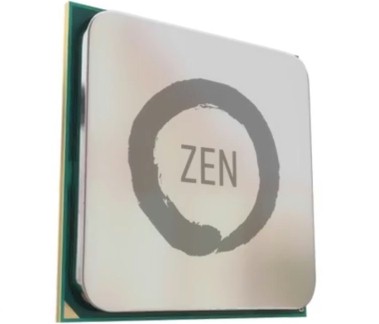
At AMD’s Epyc launch few weeks ago, Lisa Su, Mark Papermaster, and the rest of the AMD Epyc team hammered home that AMD designed its new Zen processor core for servers first. This server-first approach has implications for performance, performance per watt, and cost perspectives in both datacenter and consumer markets.
AMD designed Epyc as a modular architecture around its “Zeppelin” processor die with its eight “Zen” architecture cores. To allow multi-die scalability, AMD first reworked its HyperTransport socket-to-socket system I/O architecture for use on a chip, across a multi-chip module (MCM), and for inter-socket connectivity. AMD has named this coherent connection the Infinity Fabric.
There are several benefits of this design from which AMD benefits. Epyc uses Infinity Fabric and the modular Zeppelin die design to fundamentally change:
- The economics for designing large die area, large core count server system-on-chip (SoC) and MCM products
- Memory and I/O scalability within a socket
- The concept of socket availability and reliability over time
- The economics of designing for the commercial markets first, but using the same components for consumer markets via a different back-end production flow
- The economics of single-socket (1S) servers
AMD’s Epyc launch also showed more breadth and depth for customer support and ecosystem development than we have seen at any other AMD launch this millennium.
Infinity Fabric
Starting with AMD’s Ryzen desktop processor and Epyc server architecture, AMD will implement their scalable Infinity Fabric across all its SoC and MCM products. Think of Infinity Fabric as a superset of HyperTransport, AMD’s previous socket-to-socket interconnect architecture, now managed by the HyperTransport Consortium. Infinity Fabric is a coherent high-performance fabric that uses sensors embedded in each die to scale control and data flow from die to socket to board-level.
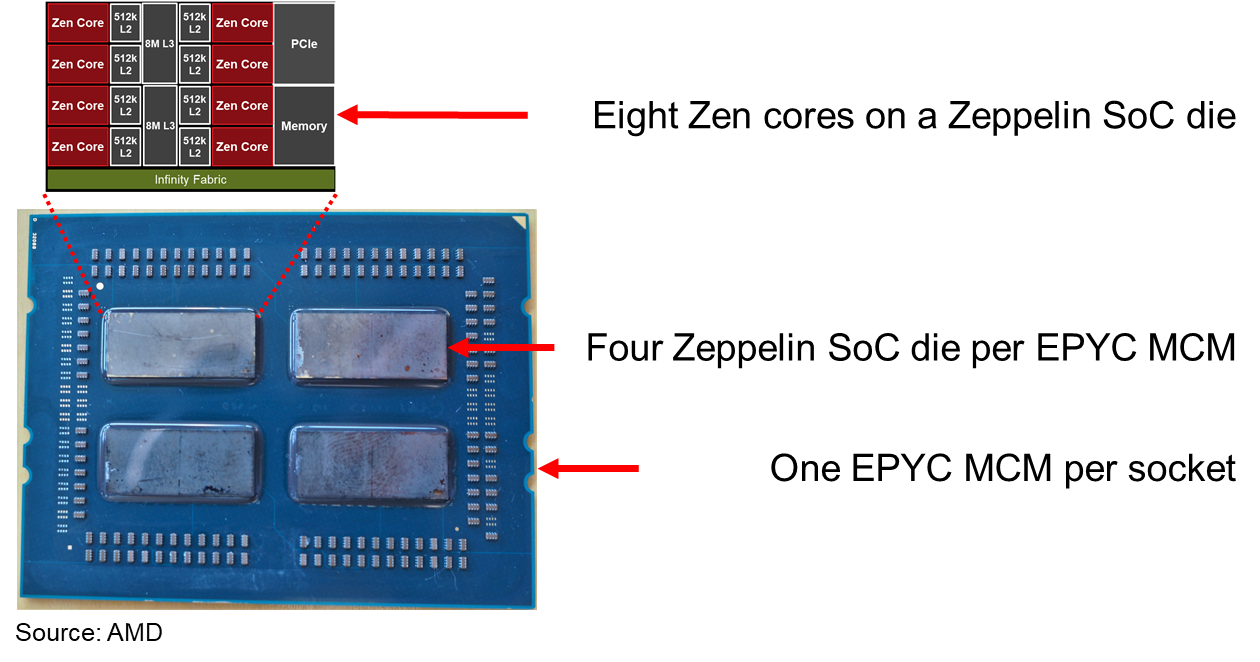
AMD redesigned HyperTransport as a software-defined interconnect fabric, and as such Infinity Fabric has separate and scalable control and data paths. In software defined networking (SDN), these paths are referred to as planes – control planes and data planes, to be specific – and the architectural implementation is similar.
Infinity Fabric’s System Control Fabric (SCF) uses on-die embedded sensors to monitor die temperature, speed, and voltage 1,000 times per second across all 64 cores within the eight Zeppelin dies that are crammed into a dual-socket system. SCF and Epyc’s system management unit work together in real-time to identify optimal operating settings. SCF uses fine-grained frequency control in 25 MHz clock speed increments, and it also enables operators to customize the balance of performance and power consumption for specific workloads or use cases. Infinity Fabric also controls power management, security, reset and initialization, and die test functions. If fewer cores are enabled, then frequency boost is automatically enabled within temperature and current delivery limits.

Customers can order Epyc processors pre-configured for:
- Consistent performance across all normal real-time variations of datacenter cooling and power delivery
- Maximum performance at a fixed power consumption, where performance may vary depending on real-time cooling efficiencies
Infinity Fabric’s System Data Fabric (SDF) connects the L3 caches to memory and to the configurable I/O lanes (described below). SDF uses the configurable I/O lanes for memory coherent communications between compute elements on a single die, between different dies mounted on an MCM, and between sockets in a NUMA server design. Using Infinity Fabric, AMD can connect multiple dies on a printed circuit board and enable the MCM to act as a single monolithic compute node.
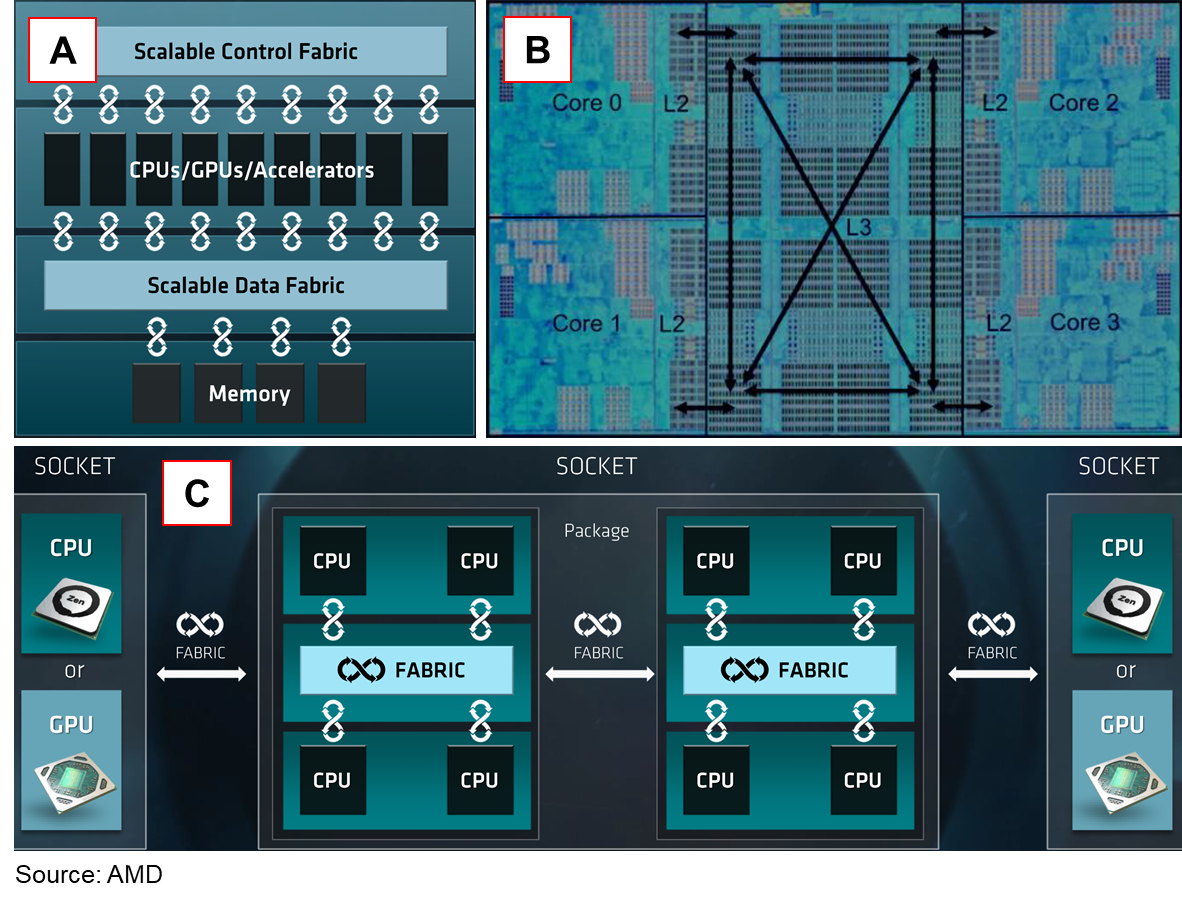
The figure above shows how AMD describes Infinity Fabric scaling:
- SCF connects compute elements
- SDF enables coherent communications among caches and between caches and memory. There are four fully interconnected core complexes on a Zeppelin die (see below for much more detail on Zeppelin). Each Infinity Fabric on-die link is four-bit point to point.
- Both SCF and SDF scale between die on an MCM and between sockets
AMD tuned a specific implementation of Infinity Fabric for two-socket servers. Future multi-socket Infinity Fabric implementations do not have to implement this specific topology, as it has a high lane count to maximize cross-sectional bandwidth. AMD’s goal was to match the cross-sectional bandwidth within each MCM with the cross-sectional bandwidth of the links between the MCMs.
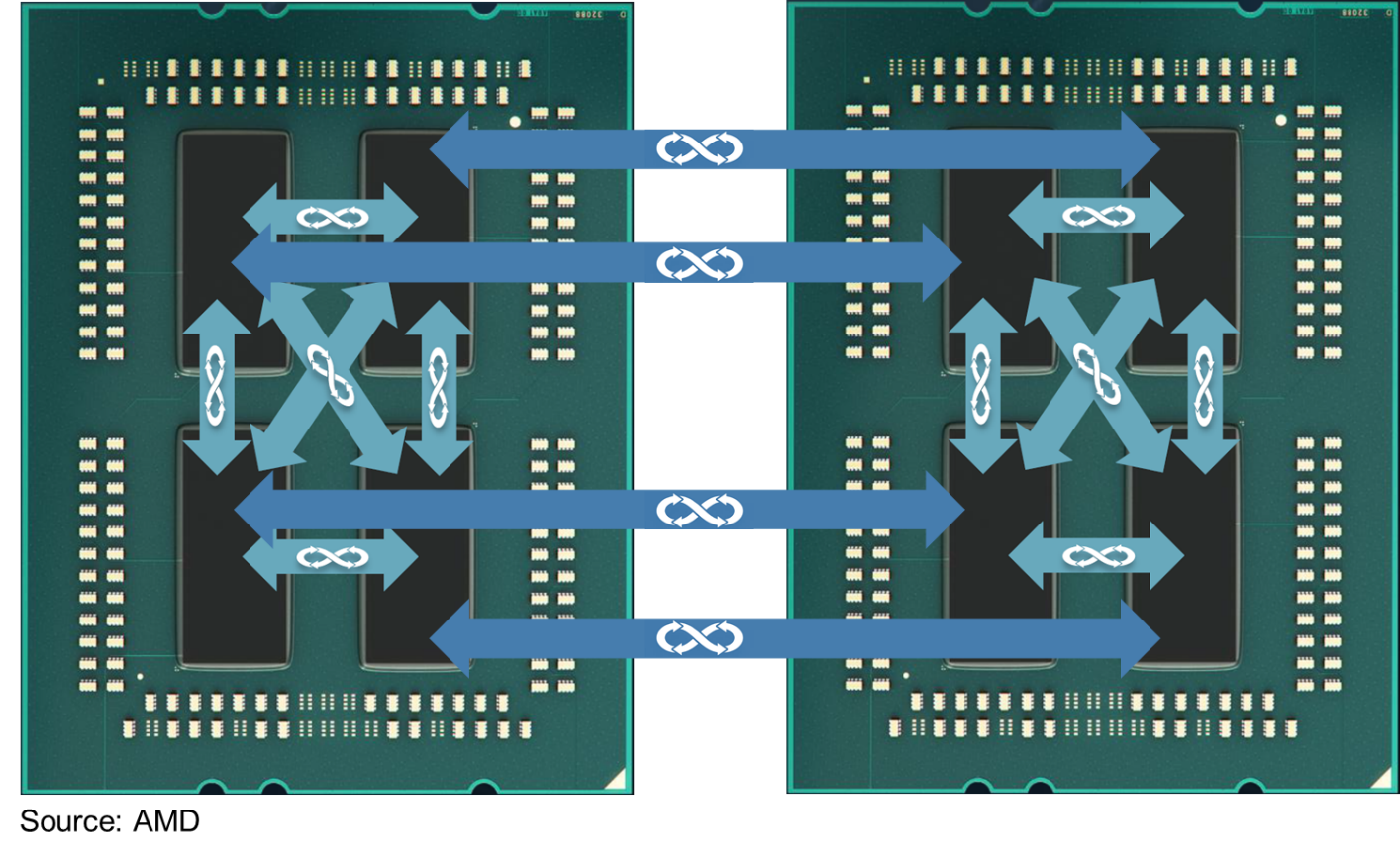
The figure above shows another rendition of a fully connected MCM highlighting that Infinity Fabric directly connects a die on one MCM to its matching die on the other MCM. This creates a sparsely connected hypercube where memory attached to one die is at most only two “hops” (intermediary memory controllers attach to the SDF, the memory controllers are in different die) away from any part of system memory. This interconnect topology is analogous to the eight-socket Opteron servers built with HyperTransport a dozen years ago as we pointed out in our original coverage of Epyc back in June, but now it is collapsed into a higher-performance two-socket design.
Each Infinity Fabric link between two Zeppelin dies on an MCM is 32-lanes wide, supporting full-speed operation on 16 lanes in each direction. We calculate that AMD is running these links at an unaggressive speed of 5.3 Gb/sec to conserve power and make MCM PCB design easier, for an aggregate throughput of 10.65 GB/sec point-to-point between chips (see Table 1 below for more detail). AMD measures the cross-sectional bandwidth of Infinity Fabric across the Epyc MCM as four times that, or 42.6 GB/sec, but we think the more important metric is the 41.4 GB/sec aggregate bandwidth of the Infinity Fabric links on each die in a two-socket system.
Each of the four Infinity Fabric connections between the two sockets uses the same serializer-deserializer (SERDES) links used by the 16 PCI-Express 3.0 lanes, but operating 20 percent faster than the PCI-Express 3.0 link, at about 9.5 Gb/sec each for 9.5 GB/sec bidirectional bandwidth between processors and an aggregate cross section of 37.9 GB/sec bidirectional bandwidth between sockets.
As a cross check, we calculate there are 256 dedicated Infinity Fabric and configurable I/O lanes available (ignoring the memory controllers and the uncore external I/O) on each Zeppelin die. (“Uncore” describes functions on a die that do not directly contribute to the compute and memory subsystems.) That seems like a great answer from a digital design point of view, as 2 to the 8th is one of our magic numbers.
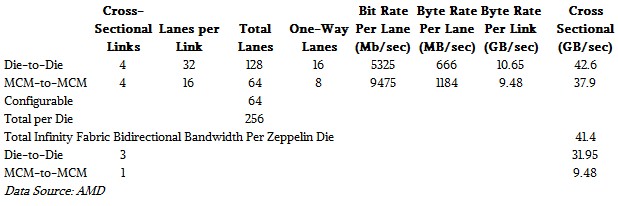
Infinity Fabric also implements a scalable Machine Check Architecture (MCA). The control fabric reports MCA errors at the die and the link level. If a failure occurs, the MCA can implement data poisoning and other reliability assurance measures. For example, as long as the die-to-die links and memory are still operating correctly, it becomes a run-time operating system policy decision to ignore a core that has become unreliable (has exceeded a threshold for deferred or correctable errors) and allow the rest of the cores in a Epyc MCM to remain operational.
MCM Interconnect Competition
Epyc’s multi-die design and MCA architecture are fundamentally different than Intel’s monolithic Xeon architecture. The Zeppelin die’s embedded error reporting and management combines with the Infinity Fabric architecture’s ability to understand that a cluster of Zeppelin dies in a MCM defines a single management and service domain.
Intel’s Embedded Multi-die Interconnect Bridge (EMIB), by comparison, appears to be a simple point-to-point physical communications link between two die, using only a physical layer protocol. I have seen no mention of higher-leveler protocols in any of Intel’s EMIB public disclosures. Intel states that EMIB can be used to decouple I/O transceivers from compute logic (because they may each perform better when manufactured in different silicon processes) or in a more general sense as a high-speed interconnect for any two die mounted on the same multi-chip package substrate.
EMIB embeds a separate bridge die into the underlying package substrate, as well as transceiver logic in each of the two die connected by the bridge. A bridge chip sits under the two die it connects (see the figure below). This seems much more complex (which implies that it is more expensive) than AMD’s approach of using standard PCBs as the planar for MCMs.
Intel has only shipped EMIB in its Stratix 10 FPGA, where EMIB is used solely to connect FPGA silicon with “connectivity tiles” to provide high-speed I/O off of the FPGA die. Intel has not shipped EMIB for the general case of connecting multiple compute die, yet. TIRIAS Research predicts that Intel will continue to espouse a perceived value for large, expensive, monolithic compute die until they introduce a multi-die compute product based on EMIB or subsequent die interconnect technologies.
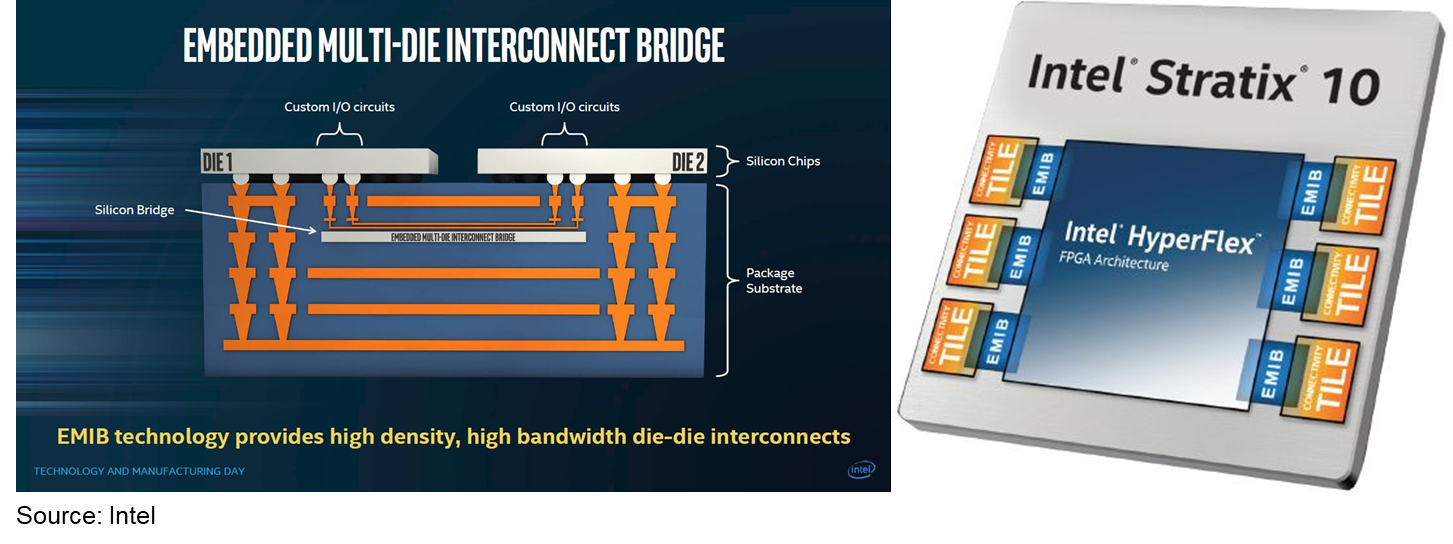
Nvidia has also been experimenting with MCMs. Its Volta generation V100 GPU die measures a reticle-filling 815 millimeters square in TSMC’s 12 nanometer process; this is likely to remain the largest production die ever shipped. Having reached the practical limits of a monolithic die, Nvidia recently published a research paper (see the figure below) that proposes three features for a future multi-chip GPU architecture:
- Create an “L1.5” cache as an extension of the L1 cache that captures remote memory changes in a local cache on each GPU die
- Use distributed scheduling for co-operative thread arrays (CTA) instead of a global scheduler, used in monolithic GPUs
- Optimize DRAM memory page allocation to minimize memory traffic between GPU die using a “first touch” page mapping policy that maps a memory page into the local memory partition of the first GPU die to request the page
Like AMD, Nvidia’s paper recommends using “a low-effort, low-cost, and low-energy link design point,” in this case 768 GB/sec, and notes that architectural innovation can improve communications, mitigating the need for more expensive and power-hungry links. It looks like Nvidia is siding with AMD in this architectural debate.
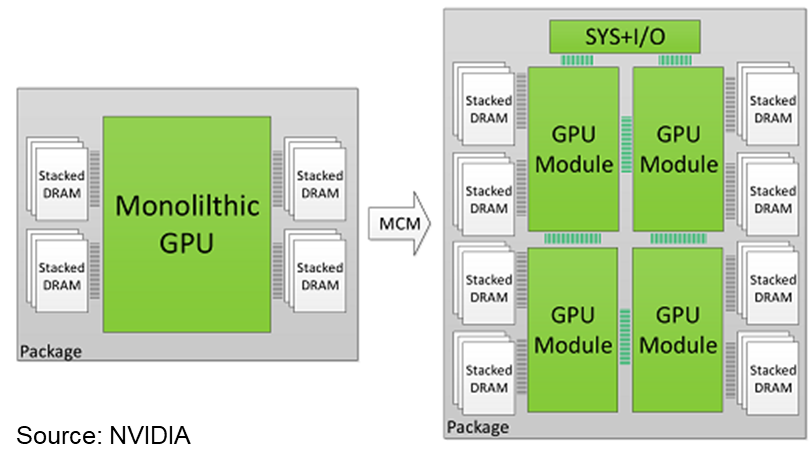
Lastly, because of Infinity Fabric, Epyc looks like a monolithic processor from a software development point of view – middleware and application developers do not need to do anything different than their standard performance tuning and instruction set optimizations. The operating system, hypervisor, container, and management framework developers also do not need to do anything differently, either, but they might choose to work with AMD to customize management and routing behaviors to their specific needs. For example, different system vendors might specify different behaviors to respond to a memory channel failure or a failed link between die. Infinity Fabric and Epyc provide a unique capability for resilience tuning.
In the second part of this article, we will expand out into the system designs that use the Epyc processors, which are ultimately what matters to server makers and buyers.
Paul Teich is an incorrigible technologist and a principal analyst at TIRIAS Research, covering clouds, data analysis, the Internet of Things and at-scale user experience. He is also a contributor to Forbes/Tech. Teich was previously CTO and senior analyst for Moor Insights & Strategy. For three decade, Teich immersed himself in IT design, development and marketing, including two decades at AMD in product marketing and management roles, finishing as a Marketing Fellow. Paul holds 12 US patents and earned a BSCS from Texas A&M and an MS in Technology Commercialization from the University of Texas McCombs School.


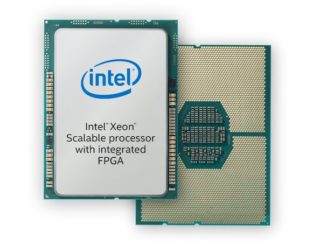

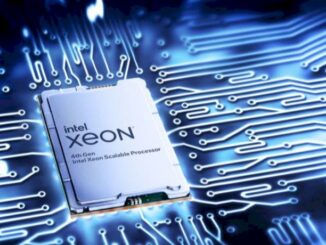
I thought Knights Landing was also using EMIB for its packaging?
AMD seems to have a real winner with their new CPUs. Haven’t heard much from Intel about Knights Hill recently but I expect it to look like Epyc and Knights Landing combined.
I would really like to see how Epyc scales in something like an SGI UV or The Machine large shared memory system.
Nice article and its second installment following has also been very thorough, but I’m still wanting to find out just what any Zen/Epyc to Vega GPU accelerator Direct Attatched GPU usage looks like via the Infinity Fabric with information provided in a greater detail than AMD and Motherboard partners have provided in their press/PDFs.
The Infinity Fabric appears to have a little bit more bandwidth compared to PCIe 3.0. I’d like to see some Epyc/Workstation Graphics workloads(NON Gaming, Professional Graphics Rendering Workloads) that can be made to utilize the Infinity Fabric for any Epyc/Vega based Graphics Workstation SKUs using any Radeon Vega “WX”(Formally Branded FirePro) GPU SKU benchmarks that are done via the Infinity Fabric instead of over PCIe. Vega GPUs are supposed to have support for the Infinity Fabric and AMD has stated that its Infinity Fabric support on Vega was comparable to Nvidia’s NVLink is scope. So what about some medial imaging benchmarks, Professional Redering(NON Gaming) benchmarks, etc. where any Epyc CPU to Vega GPU professional workloads over an Infinity Fabric based connection can be tested.
I agree with you but that would apply that AMD has some actual software that does it, which always has been AMD’s weakest link, they just don’t get it and purely relying on Opensource to come around is a doomed strategy when everybody else is pushing ahead.
u have lost me?
Vega and epyc do not currently co-reside on any infinity fabric, so how does one test it?
For now, they can only interact via pcie3.
Vega can be attached to zen cores via infinity fabric. thats how amd plans on doing raven ridge apus. they are gonna be monsters.
“Infinity Fabric connections between the two sockets uses the same serializer-deserializer (SERDES) links used by the 16 PCI-Express 3.0 lanes, but operating 20 percent faster than the PCI-Express 3.0 link”
I have seen slides of FabricS data flows, & mostly, the same channels used for pcie3 links, may optionally use fabric protocol.
So your numbers are interesting. Expect a 20% improvement in bandwidth when fabric is applied. I am surprised it isnt more.
So the already amazing speeds of nv nand memory/storage/cache, are currently measured from pcie3 DEVICES. If the nand were used solely within fabric – on vega or an MCM – then pcie3 protocol/hardware is a superfluous hindrance.
IF, pcie is limiting nand performance, then now 3500GBps speeds could be 4200GBps+ per drive on Fabric (adding 20%).
It is funny how Intel this part of AMD’s new architecture and biggest threat (Infinity Fabric), and belittles it by calling it CPU’s just “glued togeather”.
And somewhat hypocritical as it appears they are scrambling to hire a new engineering team to be able to design something similar.
And I suspect there are yet to be reviled or implemented benefits to workstations build with Infinity Fabric in both the CPU and GPU.
And here is EPYCs only “supposed” Achilles heal – Latency
From the Anandtech testing of Epyc 7601 ($4200) and Intel 8176 ($8700):
blk size 8176 latency (ns) 7601 latency (ns) delta (ns)
0.5KB 4 5 1
1KB 9 10 1
2KB 17 11 -6
4KB 20 11 -9
8KB 23 33 10
16KB 26 62 36
32KB 40 102 62
64KB 75 107 32
AMD claims 250GB/s Memory BW. From the Anandtech testing of Epyc 7601 ($4200) and Intel 8176 ($8700), 7601 w/ 2400MHz RAM showed 207GB/s, so 2666MHz RAM would achieve 230GB/s.The one good BW out of three test methods for 8176 was 165GB/s w/ 2666MHz RAM.
If using all of EPYC 7601’s 230GB/s Memory BW (w/2666MHz RAM):
64KB transfer takes 278ns + 107ns = 385ns
32KB transfer takes 139ns + 102ns = 241ns
16KB transfer takes 70ns + 62ns = 132ns
8KB transfer takes 35ns + 33ns = 68ns
4KB transfer takes 17.5ns + 11ns = 28.5ns
If using all of 8176 165GB/s Memory BW (w/2666MHz RAM):
64KB transfer takes 388ns + 75ns = 463ns
32KB transfer takes 189ns + 40ns = 229ns
16KB transfer takes 90ns + 26ns = 116ns
8KB transfer takes 45ns + 23ns = 67ns
8KB transfer takes 22.5ns + 20ns = 42.5ns
64KB transfer Epyc 20% faster
32KB transfer Epyc 5.2% slower
16KB transfer Epyc 13.7% slower
8KB transfer Epyc 1.4% slower
64KB transfer Epyc 49% faster
Latency Shmatency, no big deal.
(correction)
the last 8176 entry should say “4KB” not “8KB”
the last entry should say “4KB transfer Epyc 49% faster” not “64KB”
for large data and 64KB block sizes, Epyc wins
For small data and 4KB and 2KB block sizes. Epyc wins
For 1KB and 0.5KB block sizes it is essentially a tie.
Intel will try to manipulate benchmarks to use 16KB block sizes
I think the “Total infinity Fabric Bidirectional Bandwidth Per Zeppelin Die” is incorrect. The bandwidth shown in the figure is calculated based on one-way lanes , so the total bi-directional bandwidth should be multiplied by 2, as 82.8GB/s.
I found your article very informative but how do the inter cpu Cluster communication compare with the high speed serial links used by the Inmos T800 – granted the cpu only ran at 50Mz.